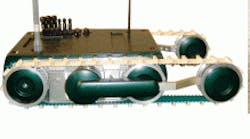New Track-Wheels for Robots
Edited by Leland Teschler
American Standard Robotics Inc., Saint Petersburg, Fla., asrobotics.com Engineering Servics Inc., esit.com Foster-Miller Inc., www.foster-miller.com Inuktun Services Ltd., inuktun.com |
When you happen upon a suspicious package sitting on the side of an Iraqi road, a remotely operated tracked vehicle can come in handy.
That’s one reason these devices have captured the imagination of defense contractors and robotics students alike. But it’s tricky to design robots able to ascend and descend stairs and slopes, cross ditches, surmount obstacles, and generally operate over rough terrain, all while moving forward or backward, or turning.
On this score, the state-of-the-art for mobile robot mechanics is still advancing. The latest improvement comes from Andrew Goldenberg, a professor at the University of Toronto and director of the University’s Robotics and Automation Lab. Goldenberg says one advantage of his design is that it can flip over and perform as well in that orientation, if need be. His design also adapts to different terrain in real time. Moreover, the basic design can scale up or down for smaller and larger mobile robots, he says.
The new platform incorporates a tensioning mechanism said to be an improvement over prior art. It uses a planetary wheel to control its center of gravity and to soften the impact of a fall. The mechanisms for tensioning and moving the center of gravity location are comparatively simple and easy to make, Goldenberg says.
Engineering Services Inc. in Toronto, a company which Goldenberg founded, has developed a commercial prototype of the design, and Goldenberg says Foster-Miller Inc., Waltham, Mass., maker of the Talon robot, is working on platforms incorporating his ideas.
The design, conceived by Goldenberg and ESI’s Dr. Jun Lin, is dubbed LMA for Link Mechanism Actuator. Its inspiration stems from an earlier concept from iRobot Corp. which uses a separate set of wheels and a track sitting outside the main track as a “flipper.” The platform can position the outside wheel set and its track to navigate stairs and big obstacles. One problem, though, is that the apparatus is on just one end of the robot. Putting the same capability at both ends would necessitate a second wheel set and track. And there are other disadvantages. The control of its center of gravity is limited, with potential consequences such as instability on ascent or descent of steep (45°) stairs, says Goldenberg. Also, the vehicle’s ability to cross wider ditches was somewhat limited relative to the platform length, he says.
Goldenberg and Lin’s solution was a novel mechanism characterized by a set of arms that position pulleys to the front or back of the robot with equal agility. The track belt stays at constant tension regardless of the track configuration. And springs built into the positioning arms give some compliance in the event the robot falls over a big obstacle. The next version of the vehicle will handle falls of roughly 2 m.
Goldenberg’s design isn’t the first to employ auxiliary arms supporting planetary wheel sets. For example, a design conceived by Hitachi in the early 1980s used a spring-slide-bar mechanism to reposition a set of wheels. One problem was the arm design couldn’t ensure an optimal path (which is a perfect ellipse) for movement of the planetary wheels, says Goldenberg. In addition, the location of the arm prevented its full rotation because of interference with the platform.
Another difficulty was that Hitachi used a gear-sprocket drive in which there were no springs. This made continuous tensioning of the track impossible as the track could change length depending on operating conditions or stresses in certain directions. Hitachi’s transmission mechanism also was complicated, involving six gears, two sprockets, and a chain.
Another such robot is the VGTV, devised by Inuktun Services Ltd. in Canada and now sold by American Standard Robotics Inc., St. Petersburg, Fla. This robot’s articulated track has an arm and planetary wheel, both attached to the chassis on each side. The articulated tracks raise a camera for surveillance and inspection. The track mechanism has six moving members activated by one motor.
But Inuktun’s vehicle has a number of disadvantages, says Goldenberg. Specifically, it has limited variation of the track configuration in only one direction. Rough terrain can be a problem, he says. The robot cannot climb stairs because it is impossible to ensure tensioning of the track based on the articulated track mechanism. Further, Goldenberg explains, the six-member planetary wheel is costly to make and install.
Goldenberg’s device gets around a lot of the problems inherent in previous designs through use of a wheel arm which lets the wheel set trace out an elliptical position trajectory. The focal points of the ellipse are at the axis of the drive and driven wheels when all wheels have the same diameter.
The arm includes a spring mechanism which implements continuous tension control of the tracks. Specifically it is composed of a follower, crank, and fixed cam. A motor drives the crank, while the cam is affixed to the robot chassis. The cam is generally a three-bar version and includes the tension-control feature in the form of a spring. A guide holding the spring keeps it straight during compression and tension. The crank couples to the tension follower and guide using a pair of slides. So connected, the tension follower and guider can rotate around an axis while extending and contracting to produce an elliptic trajectory while moving the set of wheels.
The purpose of this mechanism is to let the vehicle adapt to situations such as recovering from tumbles when it lands on its back, or climbing stairs. For example, the robot can surmount obstacles forward and back because the positioning arm can turn a full revolution to position the wheels. And the platform can be positioned such that it stays roughly horizontal while it climbs stairs or crawls over obstacles.
